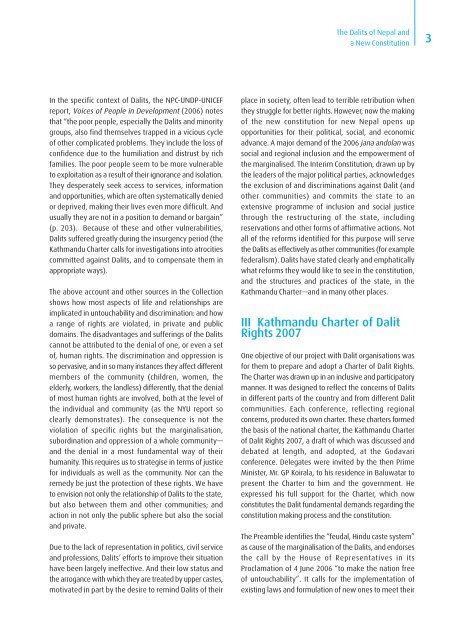The Dalits of Nepal and a New Constitution - ConstitutionNet
The Dalits of Nepal and a New Constitution - ConstitutionNet
The Dalits of Nepal and a New Constitution - ConstitutionNet
You also want an ePaper? Increase the reach of your titles
YUMPU automatically turns print PDFs into web optimized ePapers that Google loves.
<strong>The</strong> <strong>Dalits</strong> <strong>of</strong> <strong>Nepal</strong> <strong>and</strong><br />
a <strong>New</strong> <strong>Constitution</strong><br />
3<br />
In the specific context <strong>of</strong> <strong>Dalits</strong>, the NPC-UNDP-UNICEF<br />
report, Voices <strong>of</strong> People in Development (2006) notes<br />
that “the poor people, especially the <strong>Dalits</strong> <strong>and</strong> minority<br />
groups, also find themselves trapped in a vicious cycle<br />
<strong>of</strong> other complicated problems. <strong>The</strong>y include the loss <strong>of</strong><br />
confidence due to the humiliation <strong>and</strong> distrust by rich<br />
families. <strong>The</strong> poor people seem to be more vulnerable<br />
to exploitation as a result <strong>of</strong> their ignorance <strong>and</strong> isolation.<br />
<strong>The</strong>y desperately seek access to services, information<br />
<strong>and</strong> opportunities, which are <strong>of</strong>ten systematically denied<br />
or deprived, making their lives even more difficult. And<br />
usually they are not in a position to dem<strong>and</strong> or bargain”<br />
(p. 203). Because <strong>of</strong> these <strong>and</strong> other vulnerabilities,<br />
<strong>Dalits</strong> suffered greatly during the insurgency period (the<br />
Kathm<strong>and</strong>u Charter calls for investigations into atrocities<br />
committed against <strong>Dalits</strong>, <strong>and</strong> to compensate them in<br />
appropriate ways).<br />
<strong>The</strong> above account <strong>and</strong> other sources in the Collection<br />
shows how most aspects <strong>of</strong> life <strong>and</strong> relationships are<br />
implicated in untouchability <strong>and</strong> discrimination: <strong>and</strong> how<br />
a range <strong>of</strong> rights are violated, in private <strong>and</strong> public<br />
domains. <strong>The</strong> disadvantages <strong>and</strong> sufferings <strong>of</strong> the <strong>Dalits</strong><br />
cannot be attributed to the denial <strong>of</strong> one, or even a set<br />
<strong>of</strong>, human rights. <strong>The</strong> discrimination <strong>and</strong> oppression is<br />
so pervasive, <strong>and</strong> in so many instances they affect different<br />
members <strong>of</strong> the community (children, women, the<br />
elderly, workers, the l<strong>and</strong>less) differently, that the denial<br />
<strong>of</strong> most human rights are involved, both at the level <strong>of</strong><br />
the individual <strong>and</strong> community (as the NYU report so<br />
clearly demonstrates). <strong>The</strong> consequence is not the<br />
violation <strong>of</strong> specific rights but the marginalisation,<br />
subordination <strong>and</strong> oppression <strong>of</strong> a whole community—<br />
<strong>and</strong> the denial in a most fundamental way <strong>of</strong> their<br />
humanity. This requires us to strategise in terms <strong>of</strong> justice<br />
for individuals as well as the community. Nor can the<br />
remedy be just the protection <strong>of</strong> these rights. We have<br />
to envision not only the relationship <strong>of</strong> <strong>Dalits</strong> to the state,<br />
but also between them <strong>and</strong> other communities; <strong>and</strong><br />
action in not only the public sphere but also the social<br />
<strong>and</strong> private.<br />
Due to the lack <strong>of</strong> representation in politics, civil service<br />
<strong>and</strong> pr<strong>of</strong>essions, <strong>Dalits</strong>’ efforts to improve their situation<br />
have been largely ineffective. And their low status <strong>and</strong><br />
the arrogance with which they are treated by upper castes,<br />
motivated in part by the desire to remind <strong>Dalits</strong> <strong>of</strong> their<br />
place in society, <strong>of</strong>ten lead to terrible retribution when<br />
they struggle for better rights. However, now the making<br />
<strong>of</strong> the new constitution for new <strong>Nepal</strong> opens up<br />
opportunities for their political, social, <strong>and</strong> economic<br />
advance. A major dem<strong>and</strong> <strong>of</strong> the 2006 jana <strong>and</strong>olan was<br />
social <strong>and</strong> regional inclusion <strong>and</strong> the empowerment <strong>of</strong><br />
the marginalised. <strong>The</strong> Interim <strong>Constitution</strong>, drawn up by<br />
the leaders <strong>of</strong> the major political parties, acknowledges<br />
the exclusion <strong>of</strong> <strong>and</strong> discriminations against Dalit (<strong>and</strong><br />
other communities) <strong>and</strong> commits the state to an<br />
extensive programme <strong>of</strong> inclusion <strong>and</strong> social justice<br />
through the restructuring <strong>of</strong> the state, including<br />
reservations <strong>and</strong> other forms <strong>of</strong> affirmative actions. Not<br />
all <strong>of</strong> the reforms identified for this purpose will serve<br />
the <strong>Dalits</strong> as effectively as other communities (for example<br />
federalism). <strong>Dalits</strong> have stated clearly <strong>and</strong> emphatically<br />
what reforms they would like to see in the constitution,<br />
<strong>and</strong> the structures <strong>and</strong> practices <strong>of</strong> the state, in the<br />
Kathm<strong>and</strong>u Charter—<strong>and</strong> in many other places.<br />
III Kathm<strong>and</strong>u Charter <strong>of</strong> Dalit<br />
Rights 2007<br />
One objective <strong>of</strong> our project with Dalit organisations was<br />
for them to prepare <strong>and</strong> adopt a Charter <strong>of</strong> Dalit Rights.<br />
<strong>The</strong> Charter was drawn up in an inclusive <strong>and</strong> participatory<br />
manner. It was designed to reflect the concerns <strong>of</strong> <strong>Dalits</strong><br />
in different parts <strong>of</strong> the country <strong>and</strong> from different Dalit<br />
communities. Each conference, reflecting regional<br />
concerns, produced its own charter. <strong>The</strong>se charters formed<br />
the basis <strong>of</strong> the national charter, the Kathm<strong>and</strong>u Charter<br />
<strong>of</strong> Dalit Rights 2007, a draft <strong>of</strong> which was discussed <strong>and</strong><br />
debated at length, <strong>and</strong> adopted, at the Godavari<br />
conference. Delegates were invited by the then Prime<br />
Minister, Mr. GP Koirala, to his residence in Baluwatar to<br />
present the Charter to him <strong>and</strong> the government. He<br />
expressed his full support for the Charter, which now<br />
constitutes the Dalit fundamental dem<strong>and</strong>s regarding the<br />
constitution making process <strong>and</strong> the constitution.<br />
<strong>The</strong> Preamble identifies the “feudal, Hindu caste system”<br />
as cause <strong>of</strong> the marginalisation <strong>of</strong> the <strong>Dalits</strong>, <strong>and</strong> endorses<br />
the call by the House <strong>of</strong> Representatives in its<br />
Proclamation <strong>of</strong> 4 June 2006 “to make the nation free<br />
<strong>of</strong> untouchability”. It calls for the implementation <strong>of</strong><br />
existing laws <strong>and</strong> formulation <strong>of</strong> new ones to meet their








![g]k fnsf blntx? / gofF ;+l jwfg](https://img.yumpu.com/49483602/1/184x260/gk-fnsf-blntx-goff-l-jwfg.jpg?quality=85)



![+ljwfg;ef, /fHosf]k'g](https://img.yumpu.com/41604075/1/184x260/-ljwfgef-fhosfkg.jpg?quality=85)




